Questions unanswered as Mansell wins the 1992 Spanish Grand Prix: race report
The weather rendered the Spanish GP a somewhat inconclusive affair, but Mansell and Williams still won
It was a curiously frustrating event, the Spanish GP. Oh, Nigel Mansell still won, dominating in style as he brought his tally of victories equal to Jim Clark’s 25, and matching Senna’s 1991 feat of winning the first four on the trot. But what we all went there to see was whether McLaren Honda had managed to close the gap in the period since the disastrous debut of the MP4/7A in Brazil. Whether the combination of Michael Schumacher and the new Benetton B192 could continue to chip away at the wall of the Williams’ fortress.
There were plenty of tasters during Friday qualifying, when Mansell lapped barely one second faster than Schumacher and Senna (on the grid in Interlagos the respective gaps had been 2.838s and 2.199s), but then along came the rain and away was washed all of Saturday’s contest. With it went a lot of the expected answers.
Certainly, McLaren had made progress, revising the electronics and computer mapping on the hitherto troublesome and underpowered RA122E version of the Honda V12, and Benetton was likewise on a roll with the ugly B192. But how much, if anything, had they clawed back? That could not be quantified with any degree of accuracy, especially since neither Mansell nor Riccardo Patrese had been happy with the set-up they achieved on the FW14Bs when it was dry. Nobody could be sure whether the basic ground of comparison had been firm or soft.
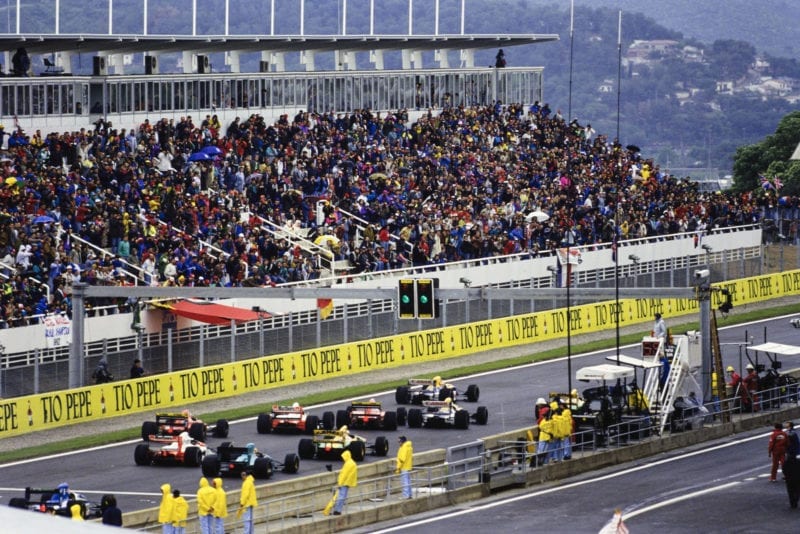
The start of the 1992 Spanish Grand Prix
Motorsport Images
The Benetton, in reality, is virtually what the Reynard F1 car would have been, which is hardly surprising since it was designed by the same man, South African Rory Byrne, with input from Technical Director Ross Brawn. The vital ingredient, the impressive Schumacher apart, is the equally remarkable Ford HB V8, where Reynard thought it would be using the Yamaha V12. Indeed, its plans for graduation to Grand Prix racing had only begun to fall apart when it realised that Jordan had got the Japanese engine instead. On current form, Eddie J must quietly be ruing the day he ever swapped the purchase of HBs, and their power and reliability, for the supply of free OX-99s.
The Japanese V12s still warp their blocks if allowed to cool too much between runs (in Brazil the team was even obliged to resort to boiling the oil before it was poured in), and the power is still a long way from competitive. Indeed, after the lacklustre Stefano Modena again failed to qualify having spun his race car when it mattered, Mauricio Gugelmin struggled in a lowly 15th place until the unit’s characteristic caught him out on the 25th lap. In the wet he was unable to short-shift because of the lack of horses, but the need to keep running up the power curve was creating excessive oversteer in the trying conditions and finally he got caught out and spun into the pit wall.
That Ford, meanwhile, was propelling the German star at the prodigious rate of knots we have come to expect. If it was not possible to draw complete conclusions about the overall competitiveness of the Benetton package, it was nevertheless thoroughly evident once again just what a good job its driver was doing.
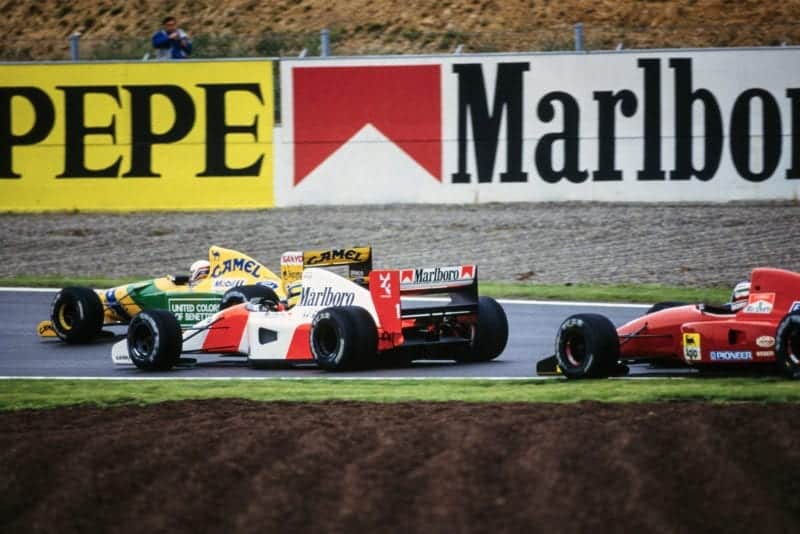
Martin Brundle leads Ayrton Senna and Ivan Capelli
Motorsport Images
In qualifying on Friday he went off at speed and clouted a wall, damaging the new car and earning little approbation within the team. It was nothing serious, because when he’s on the track he always does the business, and even when he went off again in the wet on Saturday, when he was upstaged for the first time so far by team-mate Martin Brundle, he was forgiven. He was, after all, second only on the grid to the man who’d just won the preceding three races, and this was to be only his 10th F1 outing…
Therein lay the key to the Spanish race. It told little new about the various team’s combinations, but it told a lot about the drivers themselves.
Take Schumacher. Yes, he threw it off the road in qualifying, while searching for the limit, but come the race he made virtually no errors. He crept a fraction at the start, braked, and was then modestly engulfed as Alesi came boiling through in a tremendous start from the fourth row that saw him thrust the Ferrari between the Benetton and tap Senna’s McLaren in the process. Thereafter, though, Schumacher drove with the comfortable panache of a future champion.
At the post-race conference he was genuinely surprised by Mansell’s assertion that he himself had been driving flat-out, yet was still being caught by the Benetton, and he revealed something else about his character just as he had with his outspoken but straightforward comments about Senna’s driving tactics in Brazil: as Mansell talked of how he had found an extra second at each of three corners, and thus managed to pull away again, Michael Schumacher schooled his face not to smile. He may be young, but he was not born yesterday. He knew full well that he had not increased his own pace in pursuit of the Williams, more that he had maintained his rhythm in worsening conditions, where Mansell had eased slightly. The Heuer Olivetti lap times clearly proved it.
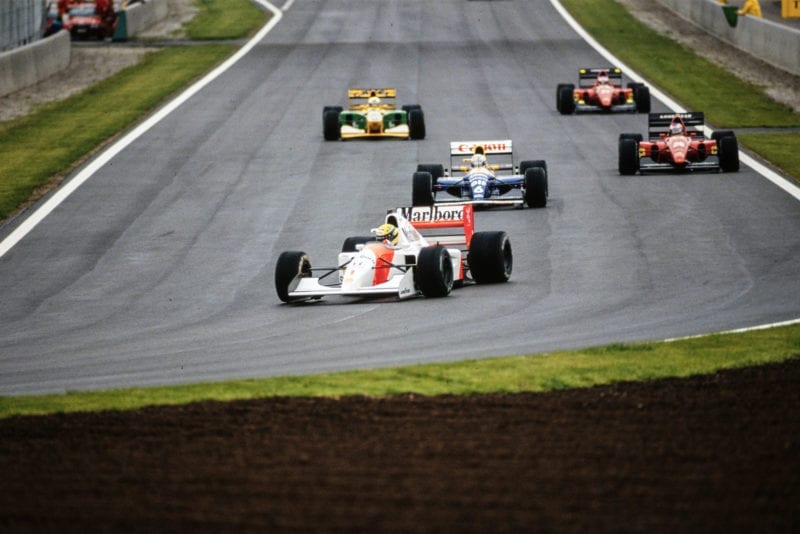
Senna ahead of Riccardo Patrese, Jean Alesi, Brundle and Capelli
Motorsport Images
Where Schumacher was so smart was in not throwing the Benetton off track by getting over excited at the prospect of catching and challenging Mansell.
“I didn’t notice that I was catching Mansell,” he confessed. “In fact, I was really surprised when I saw that the gap was less than five seconds. I thought that Nigel must have spun!”
Many other ‘stars’ at a similar stage of their careers might have been tempted to push too hard trying just that little bit more, but Schumacher knew his limits and was far too smart to overstep them even though the siren of his first GP victory seemed to be calling. That, in itself, was as impressive as the best result of his short F1 career.
Then there was Senna. If ever a driver has suffered an unexpected reversal of fortune of late, it is the World Champion. In the early stages he was dealt with by Schumacher after the latter’s weak start, and then came a real onslaught from the on-form Gerhard Berger. It is a long time since Senna truly had to deal with a challenge from a team-mate, and Gerhard’s was prolonged and relentless. Initially the gap between the two MP4/7As, in lowly fifth and sixth places in the early stages, had seesawed according to track conditions and traffic; Berger would begin to make inroads, only to drop back again. However, the Austrian persisted and by lap 17 had managed to make up time lost in a wheel-banging incident with Alesi four laps earlier. After 30 laps the two stablemates were so close that there was nothing between them. During lap 31 Gerhard finally caught Ayrton out, and as he slipped ahead he quickly pulled away despite a counter-attack. Within corners, however, he came up behind the fight raging for seventh place between Tarquini’s Fondmetal and the Dallaras of Martini and Lehto as they sandwiched Alboreto’s Footwork. JJ was busy and inadvertently delayed Berger sufficiently to enable Senna not only to close again but to pounce, and Gerhard’s occupation of third place thus never showed up on the lap charts.
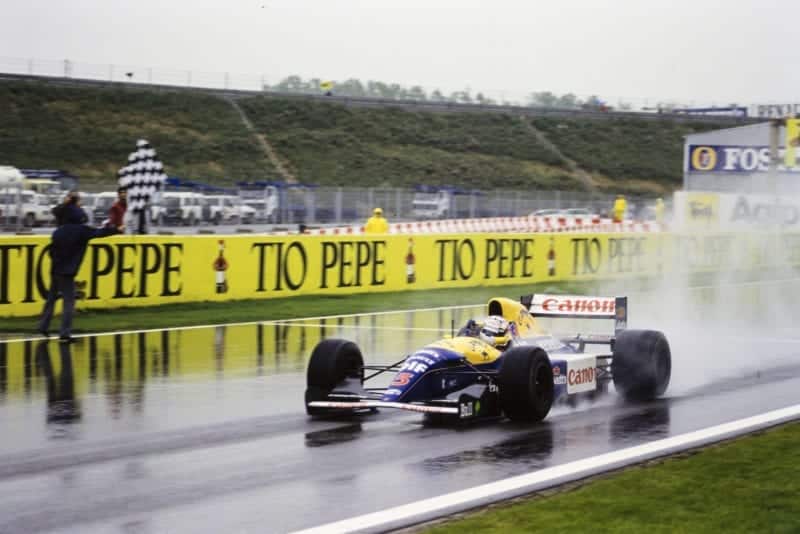
Mansell takes the chequered flag
Motorsport Images
Senna pulled away then as Gerhard passed the Finn and attempted to recover, but though the Brazilian was never thereafter challenged by his team-mate, a dismal day was not yet over. After a real tank-slapper in the second corner on lap 48, he lost it in the worsening conditions on lap 57, keeping the MP4/7A off the wall and getting under way again very quickly thanks to his innate ability to keep his orientation in a crisis, but by then he was no longer thirsting after Schumacher as he had been. Instead, the boot was on another foot, and it belonged to Alesi, who was making dramatic inroads into his advantage. After his startling getaway Jean had been muscled down from third to fifth until that incident with Berger on lap 13 delayed him further. He became the only front runner to change tyres when, on lap 33, he came in for a fresh set after a rear Goodyear had sustained damage but the stop, far from being a further handicap, was to prove crucial. The Ferrari had not been a match for the Benettons and McLarens in the less wet early going, but as the weather deteriorated so Jean came back into his own on his fresh rubber.
Part of the Frenchman’s aura is his ability to survive brushes with others, even when they are of his own making as was the incident with Brundle in Brazil. On lap 40 he and Hakkinen tangled after what appeared simply to be a racing incident, but both survived and thereafter Alesi was charging as once again he completely overshadowed team-mate Capelli. By the time Senna spun on lap 57 the Ferrari was challenging the other McLaren for fourth place and would pass it two laps later. Between laps 61 and 62 Jean then carved a whopping 14s from Senna’s advantage, and as they went into the 63rd there was nothing between them. “The conditions were very difficult,” said Senna, “especially during the last 10 or 15 laps when the tyres were worn.” That, and the refusal to concede a place, would cost him dear. Under pressure from Alesi that lap, the World Champion spun again, and this time there was sufficient damage to the McLaren’s rear suspension to prevent him continuing. It was a driving error, plain and simple, and one that cost him at least three championship points…
Alesi’s was a superb performance that fully illustrated that one underestimates the Frenchman at one’s peril, but for Patrese and Capelli the Spanish GP brought nothing but anger directed at themselves. As is now pretty much the norm in 1992, Riccardo played a supporting role to Mansell, but was pushing him very hard when he lost control on lap 20 and spun quite heavily into a wall. It was an uncharacteristic mistake from the veteran, as was Capelli’s demise from sixth place, in a Ferrari that was steadily losing power, when he too spun on lap 63.
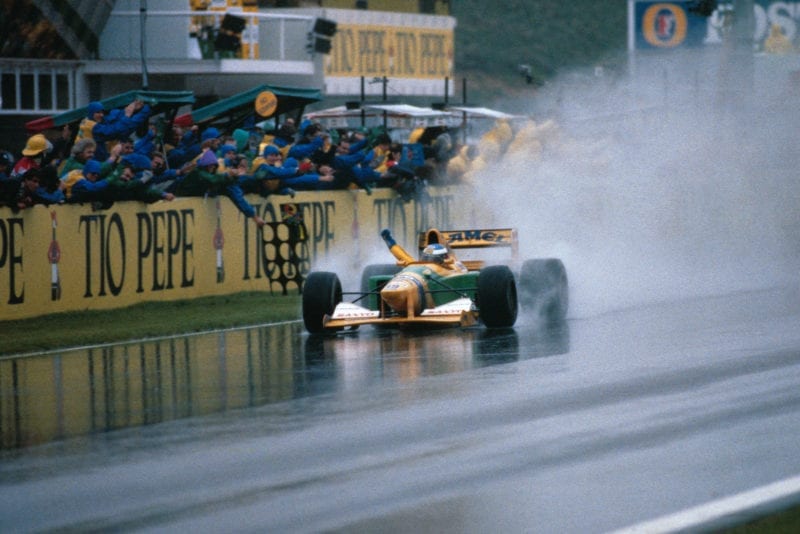
Michael Schumacher punches the air as he crosses the line in second
Motorsport Images
In 1991 Erik Comas was expected to outqualify Thierry Boutsen, but though that didn’t happen much, the Frenchman is now established as the faster of the two Ligier drivers. As the Belgian trailed him prior to retiring with engine trouble, Comas starred in seventh place until a brace of spins. He did not recover from the second. Spins also accounted for poor old Tarquini, a real racer who just gets on with the job, and Lehto. The Italian inherited Comas’ seventh place until Alboreto’s straightline speed advantage took him by on the 42nd lap, but Gabriele was closing on the Footwork driver towards the end until his departure. Lehto ran throughout in company with Martini, the duo swapping places fiercely, while fellow Finn Mika Hakkinen chased energetically after Bertrand Gachot’s well-driven Venturi until that car blew up. After his incident with Alesi Hakkinen looked set for a finish until he too lost it, joining team-mate Johnny Herbert in retirement. The new Lotus 107 had been unveiled in the paddock at Barcelona but the old 102Ds had what should be their last race. They lacked grip in qualifying, and Herbert’s in particular had horrible snap oversteer in the wet. The Briton disappointed himself by spinning out, but not the fans who relished his consummate skill passing cars left, right and centre as he caught up with Hakkinen and Gugelmin. By the time he departed on lap 14 Martin Brundle’s fourth unhappy GP of 1992 had already been long finished after two spins caused by clutch problems.
There was one other star in a race that settled into tedium at one stage, only to burst into life in its second half, and that was Karl Wendlinger. Yet again the Austrian qualified well in the March, but in the confusion on the grid as the weather closed in, the team refused to breach the regulations by changing tyres after the five minute board. Others did — Footwork was fined $5000 for doing so on Alboreto’s car — and thus he had to start on slicks. It was a hopeless cause and he swapped to wets on lap six, whereafter he sat resolutely behind Comas for lap after lap. In the end eighth was poor reward; had he started on wets he would certainly have scored his first points.
In the end it was, of course, Mansell who made the strongest points in Spain. And true to form, he combined good with bad. After the 25th victory of his F1 career he steadfastly refused — in extremely trenchant terms — to acknowledge that his car had a technical advantage that seemed plain to everyone else. Or to admit that he had eased off when Schumacher caught him. In fact, he had driven brilliantly. In the past he has been criticised for going too hard throughout a race; here he demonstrated great cunning by letting Schumacher come to him, almost willing the German to overstep the mark in his pursuit. And, when the gap became threatening and Schumacher still hadn’t lost control, he simply raised his game and pulled away again. It was the thinking of a champion. A signal, perhaps, that he really can put the championship together this year. And yet his post-race gracelessness served again to indicate that, in his own way, he is just as vulnerable as Senna, notwithstanding the 36 point cushion that separates them.
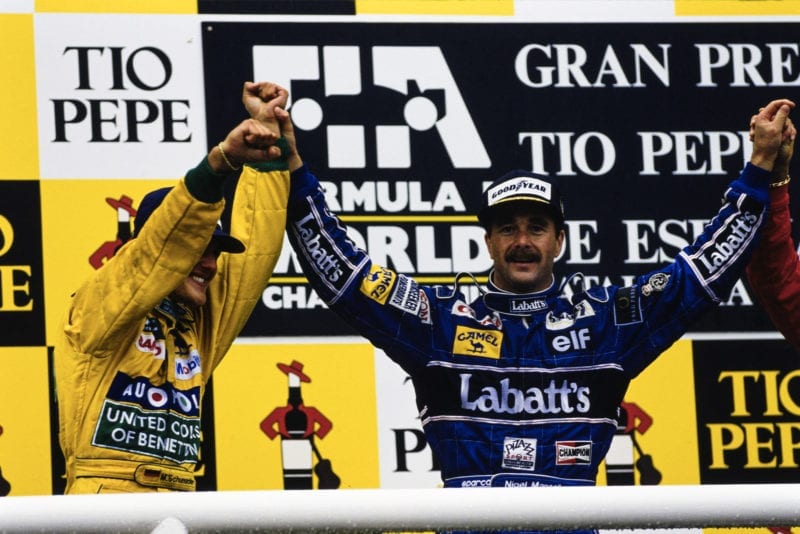
Mansell and Schumacher celebrate on the podium
Motorsport Images
On the track in Spain Nigel Mansell was a danger to every other drivers’ aspirations; off it he again proved a danger only to his own credibility.
SPANISH GRAND PRIX, Barcelona, May 3
65 laps of 2.949-mile (4.745 km) circuit (191.681 miles; 308.421 km)
1st: Nigel Mansell – Williams FW14B-Renault V10 – 1h 56m 10.674s
2nd: Michael Schumacher – Benneton B192-Ford HB V8 – 1h 56 m 34.588s
3rd: Jean Alesi – Ferrari F92A-Ferrari V12 – 1h 56m 37.136s
4th: Gerhard Berger – McLaren MP4/7A-Honda V12 – 1h 57m 31.321s
5th: Michele Alboreto – Footwork FA13-Mugen V10 – 64 laps
6th: Pier-Luigi Martini – Dallara BMS 192-Ferrari V12 – 63 laps
